About CST
Since our establishment in 1980, Custom Sensors & Technology has been dedicated to providing customers with robust integrated process monitoring equipment and accessories. Our years of experience designing sample handling systems and photometric instruments for industries such as food/beverage, pulp/paper, pharmaceutical/bio-processing, and chemical/petrochemical allow us to tackle the next set of process analytical challenges. CST is a full-service provider offering application engineering and development, opto-mechanical-chemistry integration design/fabrication, factory acceptance testing, custom installations, customer support, and in-house repair. We have a strong commitment to continued development of new products as evidenced by our patent portfolio and long term historical sustainability.
Mission Statement
Custom Sensors & Technology commits itself to providing our customers with products that ensure profitability, respect for our planet and the safety of staff and community. We pride ourselves on our ability to devise innovative process monitoring solutions for difficult applications that are simple and safe to use and implement. Our goal is to create products that add value to your process, and we stand behind our workmanship.
Guarantees
Products from Custom Sensors & Technology are tested thoroughly by our engineers and application scientists before shipment and are guaranteed to perform reliably.
Timeline
1980
First Office Location: We started our journey, as most great companies do, with a great idea and a garage in suburban St. Louis.
1980

First Analyzer Order: Custom Sample Systems’ first integrated system measured NO, NO2, and NOX. The nitrogen oxides were products of combustion reactions that occurred in the system’s controlled oven and heated sample lines.
1981
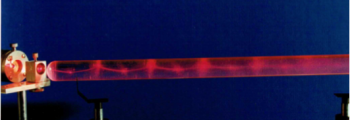
Attenuated Total Reflectance (ATR) Probe: We developed the ATR probe to measure the concentration of highly absorbent liquids.
1982
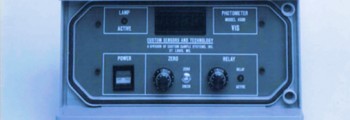
Model 4500 Photometer VIS: Our first photometer measured VIS and NIR wavelengths. After the success of the 4500, we filed for a patent which was issued in 1987.
1982

Model 4500 Sample System: Our first on-line analyzer placed a lamp and detector directly on the customer’s pipeline. This was also our first application to utilize a large volume flow cell.
1983
Second Office Location: We outgrew the garage location and moved to a permanent office space.
1984

8200 Series Oxygen Analyzer Sample System: The 8200 Oxygen Analyzer monitored oxygen levels while our H2S scrubber removed hydrogen sulfide from gaseous streams.
1984
H2S Scrubber: The development of our H2S scrubber allowed for the removal of hydrogen sulfide (H2S) from gaseous streams without impacting the oxygen concentration. The contents of the scrubber change from blue-green to black as the active material is used up.
1985

82B-35E Trace Oxygen Analyzer: Growing upon the 8200 Oxygen Analyzer technology, we added the ability to monitor additional gases and to sound alarms at specific levels.
1987

Photometric Analyzer with Flow Cell: We discovered new ways to monitor process streams using fiber optic cables. Fiber optics made it possible to install our flow cells on-line and mount the electronics away from the customer’s process. Additional improvements allowed customers to monitor their process from a control room.
1987
Our First Patent: Patent 4637730, “Optical and Electronically Compared Absorptiometer”
1989
Portable Photometric Analyzer with Transmission Probe: We developed portable versions of our analyzers to accompany our variable path length Fiber Optic Transmission Probe.
1990

Series 6000 Photometric Analyzer: Our first PLC based analyzer consolidated all electrical components into one enclosure. We started working with low-volume process streams and developed our first low-volume cross flow cells.
1993
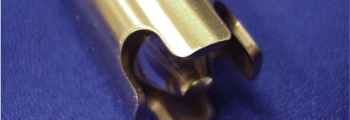
Redesigned Attenuated Total Reflectance (ATR) Probe: Improving on the first ATR probe, this newer design permitted insertion directly into a process line. The ATR probe measured high concentration samples, ranging from 4000-5000 AU/cm.
1993
Our Second Patent: Patent 5241368, “Fiber-Optic Probe for Absorbance and Turbidity Measurement”
1995
Our Third Patent: Patent 5408313, “Optical Interface Coupler and System for Photometric Analysis”
1995
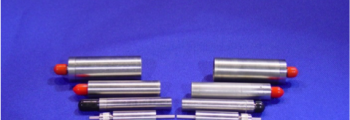
Optical Interface Couplers (OICs): We developed our OICs to be inserted into our low-volume cross flow cells and connected to our analyzers via fiber optic cables.
1999

Absorbance Photo-X: As our knowledge of absorbance monitoring techniques expanded, we designed a new line of filter-based photometers to measure application-specific wavelengths of light–produced by either an LED or tungsten halogen lamp–ranging from 400-2000nm. Pictured are the 5800 Series NIR Absorbance Photo-X (left) and the 5300 Series VIS Absorbance Photo-X (right).
1999
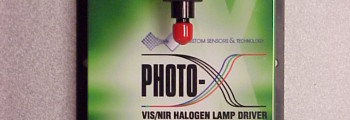
Halogen Lamp Driver (HLD-100): The Photo-X created a need for a light source to measure a broad range of wavelengths. The HLD-100 could produce light at wavelengths from 380-2200nm.
2002
Third Office Location: We outgrew our second office location and moved to our current space in Fenton, MO.
2002

Fluorescence Photo-X: The 5300 Series UV-VIS Photo-X utilized our UVF-100 Xenon Flash Lamp as its light source, expanding our measurement range into the UV as low as 200nm. This Photo-X could be configured to make either fluorescence or absorbance measurements.
2002
Fiber Optic Micro Flow Cells and Micro Optical Interface Couplers (mOICs): We developed the Micro Flow Cells and mOICs for very low volume applications. The mOICs were designed for use in our flow cells, but could be connected to any photometer or spectrometer via fiber optic cable.
2003
Deuterium Lamp Driver: We designed the Deuterium Lamp Driver to be an alternative to the UVF-100 Xenon Flash Lamp for applications in the deep UV.
2003
PT-100 Photometric Transceiver: We introduced the PT-100 as a smaller and more cost effective alternative to the Absorbance Photo-X line. Instead of a bulky flash lamp, the PT-100 utilized an LED to produce light that could be filtered to application-specific wavelengths.
2005
Our Fourth Patent: Patent 6891606B2, “Real-Time On-Line Sensing and Control of Mineral Scale Deposition from Formation Fluids”
2007
Our Fifth Patent: Patent 7274443 B2, “Corrosion Monitoring System, Optical Corrosion Probe, and Methods of Use”
2008
Our Sixth and Seventh Patents: Patent 7382458 B2, “Fiber Optic Fluid Probe” and Patent 7440098 B2, “Spectroscope and Method of Performing Spectroscopy Utilizing a Micro Mirror Array”
2008

Front Surface Fluorescence Probe: Our Front Surface Fluorescence Probe was designed for use with the 5300 Series Photo-X to measure fluorescence from the surface of a liquid, solid or slurry.
2009
Our Eighth Patent: Patent 7508506 B2, “Method and Apparatus for Performing Spectroscopy Downhole Within a Wellbore”
2010
Our Ninth Patent: Patent 7719680 B2, “Spectroscope and Method Performing Spectroscopy Utilizing an Adaptive Optical Element”
2010
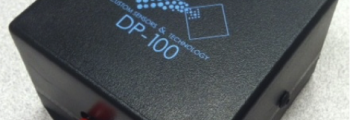
DP-100 Photometric Transmitter: Improvements to the PT-100 resulted in the DP-100. Like its predecessor, the DP-100 uses LEDs to emit light for absorbance applications ranging from 250-1500nm. However, unlike the PT-100, the DP-100 does not require the use of optical filters to isolate specific wavelengths of light.
2015
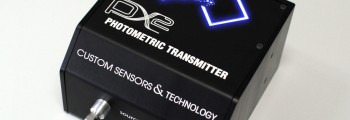
PX2 Photometric Transmitter: The PX2 is the newest member of our analyzer family. We used our favorite features from our previous products, and a few new ones, to develop the PX2. The modular design allows for the use of different light source and detector combinations to monitor 1-2 analytes at wavelengths ranging from 185-2550nm. Multiple 4-20mA outputs allow for dual channel measurements and compensations for factors such as pH, temperature, pressure, and conductivity.
2016
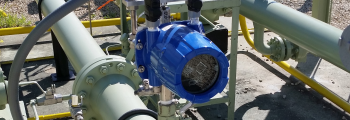
PX2 in situ: Fluorescence-equipped PX2 with retractable Front Surface Fluorescence Probe measuring refined product in situ. The PX2 and associated fiber optic accessories can be packaged in a variety of ways to meet customer requirements.
2017
Automated Extraction System (AES): The AES combines the PX2 Photometer with a programmable sampling system that performs liquid-liquid solvent extractions from sample drawn directly from a process line.
2017

H2S Analyzer: We’ve packaged the PX2 with our long path length flow cells, OICs, and scrubbers to create a system capable of monitoring H2S concentrations as high as 0-100% and as low as 0-10ppm.
2018
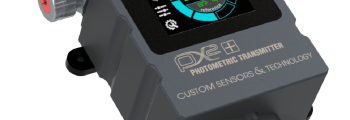
PX2+: The PX2+ is a highly improved version of our original PX2 photometer. The PX2+ is housed in a waterproof NEMA4X enclosure and features a 3.2″ capacitive touch LCD. This allows users to view data and calibrate directly on the unit.
